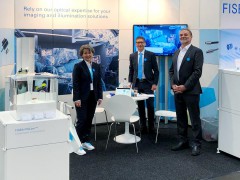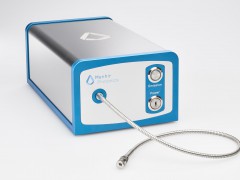
Laser method could detect hazardous materials rapidly and remotely
source:Optics.org
release:Nick
keywords:Lasers;multi-dimensionalcoherentspectroscopy;spectroscopy
Time:2017-10-12
University of Michigan researchers develop multi-dimensional spectroscopy technique to spot explosives, dangerous gases.
Researchers at the University of Michigan (U-M), Ann Arbor, MI, US, have developed a new, laser-ba sed method that could rapidly and precisely detect chemicals such as explosives and dangerous gases. Eventually this method, said Steven Cundiff, physics professor in Michigan’s College of Literature, Science and Arts,could be used in security systems in airports, for enviro nmental mo nitoring of pollutants or even to detect hazardous chemicals on the battlefield.The study, conducted by physics research fellow Bachana Lomsadze, has been published inScience.
Lomsadze and Cundiff's method combines two techniques that accelerate laser-based detection of chemicals – while doing it accurately. The first technique is based on the same principle as nuclear magnetic resonance spectroscopy, which uses radio frequencies to identify the structure of molecules.
Here, the researchers use a method called multi-dimensional coherent spectroscopy, or MDCS. MDCS uses ultrashort laser pulses to precisely identify gases. When the scientists bounce the laser pulses through the mixture of gases, those pulses can read the specific wavelengths of light that certain gases absorb.
Barcode effect
Cundiff commented, "Sending a spectrum of through a sample will result in absorption of certain wavelengths leaving black stripes in the exiting transmitted light. Where the black stripes are gives you a barcode that tells you what kind of molecules are in the sample."
He added, “Scientists have been working on similar, simpler methods. Many significant molecules have rich spectra for certain wavelengths, in the visible but also infrared ranges. But this process becomes difficult when scientists try to identify gases in a mixture. Previously, scientists relied on comparing what they measured against a catalogue of molecules, a process that requires high performance computers and a significant amount of time.
"Our method takes from between a bout 15 minutes to a few hours using traditio nal approaches to MDCS. To speed up the process while maintaining accuracy, we combined MDCS with another method called dual comb spectroscopy.”Frequency combs generate spectra consisting of equally-spaced sharp lines that are used as rulers to measure the spectral features of atoms and molecules with extremely high precision. Using two frequency combs (“dual”) provides an elegant way to rapidly acquire a high resolution spectrum without mechanical moving elements such as a corner cube, which usually limits how long it takes for the researchers to measure a spectrum.
Practical applications"This approach could allow the method of multidimensional coherent spectroscopy to escape the lab and be used for practical applications such as detecting explosives or monitoring atmospheric constituents," Cundiff said.
Lomsadze and Cundiff applied their method to a vapor of rubidium atoms that contained two rubidium isotopes. The frequency difference between absorption lines for the two isotopes is too small to be observed using traditional approaches to MDCS, but by using combs, the U-M scientists were able to resolve these lines and assign the spectra of the isotopes based on how the energy levels were coupled to each other.
Next, the researchers plan to add a third laser that could even greater speed up their ability to identify gases. They also plan to use lasers based on fiber optics so that they can look further into infrared light, which would expand the number of chemicals they would be able to identify.
- RoboSense is to Produce the First Chinese Multi-beam LiDAR
- China is to Accelerate the Development of Laser Hardening Application
- Han’s Laser Buys Canadian Fiber Specialist CorActive
- SPI Lasers continues it expansion in China, appointing a dedicated Sales Director
- Laser Coating Removal Robot for Aircraft
 FISBA exhibits Customized Solutions for Minimally Invasive Medical Endoscopic Devices at COMPAMED in
FISBA exhibits Customized Solutions for Minimally Invasive Medical Endoscopic Devices at COMPAMED in New Active Alignment System for the Coupling of Photonic Structures to Fiber Arrays
New Active Alignment System for the Coupling of Photonic Structures to Fiber Arrays A new industrial compression module by Amplitude
A new industrial compression module by Amplitude Menhir Photonics Introduces the MENHIR-1550 The Industry's First Turnkey Femtosecond Laser of
Menhir Photonics Introduces the MENHIR-1550 The Industry's First Turnkey Femtosecond Laser of Shenzhen DNE Laser introduced new generation D-FAST cutting machine (12000 W)
more>>
Shenzhen DNE Laser introduced new generation D-FAST cutting machine (12000 W)
more>>







